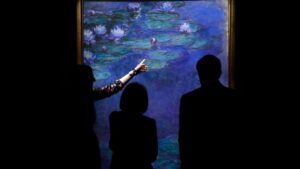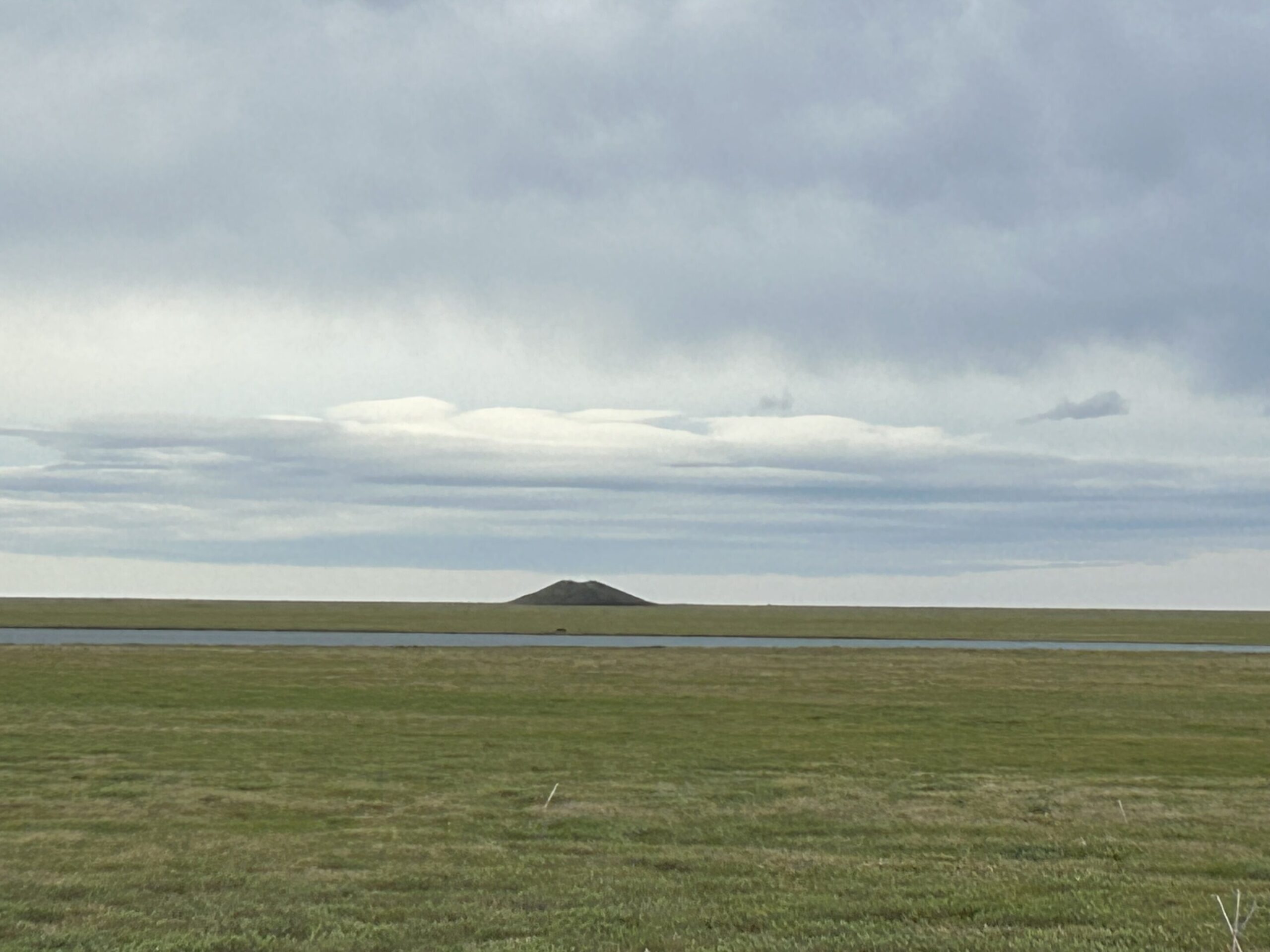
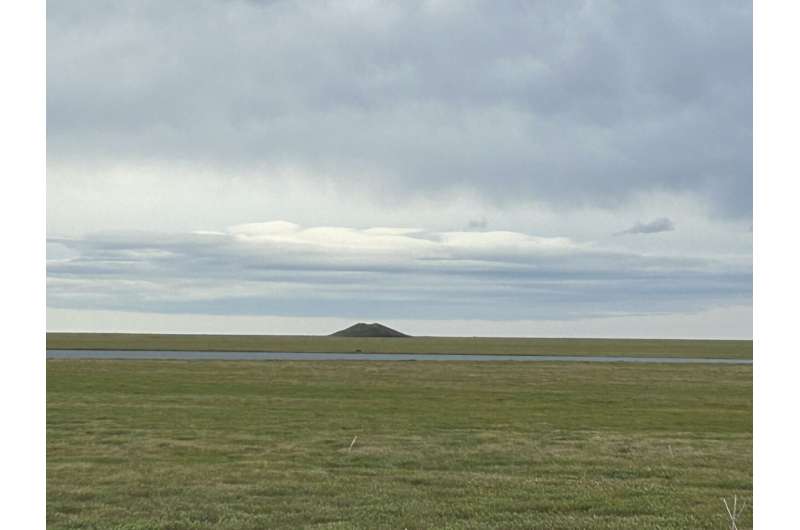
A permafrost created a pingo or “ice pimple” in the North Slope of Alaska. Scientists from Sandia National Laboratories used a fiber-optic cable to study permafrost in the Arctic seafloor to improve understanding of global climate change. Credit: Sandia National Laboratories
The Arctic is remote, with often harsh conditions, and its climate is changing rapidly—warming four times faster than the rest of the Earth. This makes studying the Arctic climate both challenging and essential to understanding global climate change.
Scientists at Sandia National Laboratories are using an existing fiber optical cable from Oliktok Point on the North Slope of Alaska to study Arctic conditions seabed up to 20 miles offshore. Christian Stanciu, project leader, will present their latest findings on Friday 15 December AGU’s Fall Meeting in San Francisco.
Their goal is to determine the seismic structure of kilometers of the Arctic seabed. Using an upwelling technique, they can identify areas of the ocean floor where sound travels faster than the rest of the ocean floor, typically due to more ice. They identified several areas with a lot of ice, said Stanciu, a Sandia geophysicist.
The scientists also used the cable to determine temperatures across the stretch of seabed and monitored temperature changes over seasons. This data, unlike any previously collected, was inserted into a computer model to infer the distribution of undersea permafrost, said Jennifer Frederick, a computational geoscientist.
“One of the innovations of this project is that we can now use a single fiber to get acoustic and temperature data,” Stanciu said. “We have developed a new system to collect both types of data remotely using one fiber strand. We are getting some interesting results.”
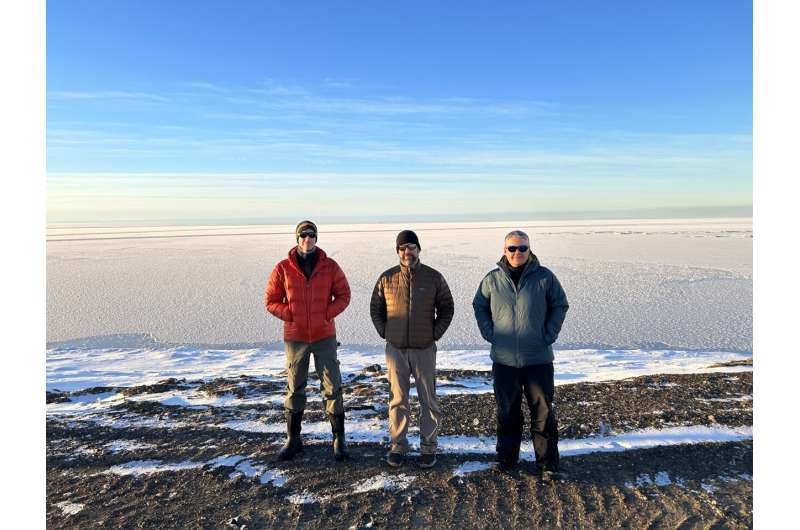
Sandia National Laboratories researchers Michael Baker, Rob Abbott and Christian Stanciu stand in front of the frozen Beaufort Sea on the North Slope of Alaska. By sending laser pulses down a fiber optic cable under the seabed, the researchers study permafrost in the seabed. Credit: Sandia National Laboratories
Permafrost and reflected light
Like leftover roast turkey that’s been sitting in the back of the freezer since Thanksgiving, Arctic permafrost is a banquet just waiting to be thawed. Specifically, as the once-living matter frozen during the last ice age thaws, microbes begin to digest it and produce waste gases such as methane and carbon dioxide, Frederick said. Scientists are studying just how big a microbial banquet is frozen in the arctic and how big an impact those gases can have on the global climate.
To study permafrost on the Arctic seafloor, the researchers used pulses of laser light shot down an undersea telecommunications fiber-optic cable buried off the coast of Alaska, north of Oliktok Point. Small imperfections in the cable caused light to bounce back to a sensor system.
By capturing this light at two wavelengths, or colors, and comparing them, the researchers were able to determine the temperature of the cable every yard, Frederick said. This is called distributed temperature sensing.
By looking at light of a different wavelength, the researchers were able to detect when the cable was strained by a passing sound wave. This so-called distributed acoustic sensing provided information about the structure of the ocean floor down to depths of one to three miles, Stanciu said.
Using this method, the scientists believe they have identified the bottom of the sea floor permafrost at about a quarter of a mile deep. They also found another area with unusually large amounts of ice, possibly consistent with a pingo or “ice pimple,” a dome-shaped mound formed by ice pushing upward, he added. The data analysis for the measurements was done primarily by Sandia intern Brandon Herr.
“The fact that we can monitor the temperature continuously, we can now pick up changes from year to year and season to season,” said Frederick. “Specifically, we’re looking for unexplained hot spots. We think we’ll be able to see areas of seafloor seeps — kind of like fountains coming out of the ground, except on the seafloor. We’re interested in them because they’re carriers of deeper, carbon-rich fluids and is indicative of warming and change.”
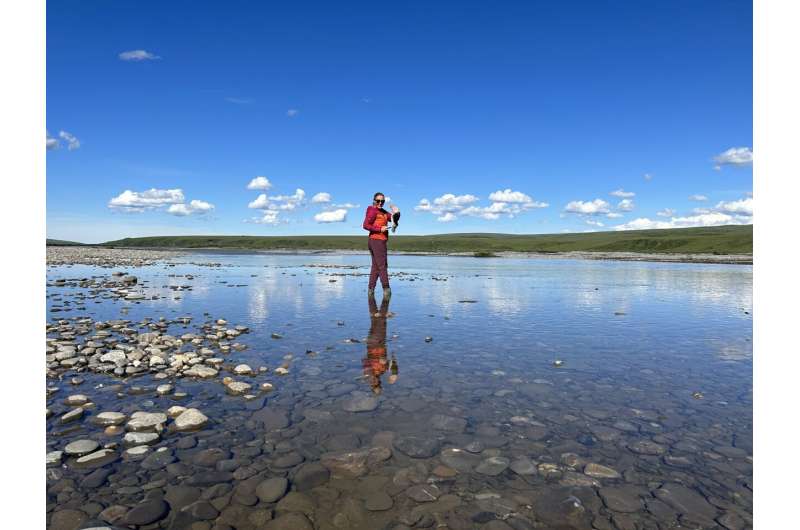
Sandia National Laboratories researcher Jennifer Frederick explores a river on the North Slope of Alaska. Studying permafrost in the Arctic seafloor can improve our understanding of global climate change. Credit: Sandia National Laboratories
History and innovations
Sandia was collect climate data of northern Alaska for over 25 years. The current research project started about a year ago and is continuing previous work on the same fiber optic cable by Sandia geophysicists Rob Abbott and Michael Baker.
One recent innovation from Stanciu’s team is a fully operational system that enables near-real-time remote data collection. This reduces the time and cost of traveling to Oliktok and the risk of losing data when the system is unattended, Stanciu said. Acoustic and temperature data cannot be collected at the same time, but one or the other can now be collected continuously.
One challenge the team solved during the first year of the project was determining how to calibrate temperature data of the fiber optic cable, Frederick said. Commonly, distributed temperature sensing systems are built with self-monitoring systems such as fiber that doubles on itself for redundancy or with built-in thermometers. However, since the team was using a telecommunications dark fiber, they needed computational models to validate the seasonal temperature changes they detected. The data analysis for this was done primarily by Sandia intern Ethan Conley.
Frederick uses the data from the distributed temperature sensing and the results from the distributed acoustic sensing modeling to set constraints on a geophysical modeling code developed by Sandia. The code models liquids and gases flowing through soil underground. Frederick uses this code to model 100,000 years of geologic history for the studied stretch of Arctic seafloor, including the average temperature of the most recent ice age and how much sea level has risen. The results of the model are maps of the current distribution of undersea permafrost.
Limitations of the interrogator system the team uses, including the power of the laser and sensitivity of the sensors, prevent the scientists from collecting data more than 18-25 miles from the ocean, Frederick said. With improvements to the system, she hopes to push the distance further.
“This project has a lot of different pieces,” Frederick said. “I’m looking at temperature and Christian looks into acoustics to get an underground model. You really need all these pieces to say something about the bigger picture of the current distribution of permafrost and whether we’re seeing changes like seeps and how that plays into the bigger picture of greenhouse gas emissions. Using new tools and pushing them to their limits to see what we can learn is really cool.”
Provided by
Sandia National Laboratories
Quotation: Scientists Use Fiber Optic Cable to Study Arctic Seafloor Permafrost (2023, December 15) Retrieved December 16, 2023, from https://phys.org/news/2023-12-scientists-fiber-optic-cable-arctic.html
This document is subject to copyright. Except for any fair transaction for the purpose of private study or research, no part may be reproduced without written permission. The content is provided for informational purposes only.
Free TikTok Coins: Insider Secrets
مولدي العملات TikTok: النجاح والفشل
Legitimate Ways to Get Free Coins in LivU Video Chat
Where to Find Free Spins in Coin Master: Your Guide
Boost Your Avakin Life Avatar with Free Avacoins
Free Credits in Bingo Blitz: Insider Secrets
TikTok Coin Hack Myths Debunked
TikTok Coin Hack Myths Debunked
The Art of Earning TikTok Coins
Get Free TikTok Coins: The Ultimate Guide
Plongée approfondie dans la génération de pièces sur TikTok
TikTok Coin Generators: Fact vs. Fiction
Conseils de sécurité pour les générateurs de pièces TikTok
TikTok Coin Generator Review: What Works Best?
Ricompense in Monete TikTok: Ciò che Devi Sapere
Are TikTok Coin Generators Worth It?
Impulsa tu Cuenta de TikTok con Monedas Gratis
How to Get TikTok Coins Effortlessly
Free TikTok Coins Today: Quick Tips
Unlimited TikTok Coins: Myth or Reality?
El Impacto de las Monedas TikTok en tu Perfil
The Ultimate Game Changer: Free Coins in LivU Video Chat
What Every Player Should Know: Coin Master Free Spins Farming
TikTok Coin Farming: What You Need to Know
استراتيجيات النجاح باستخدام مولدي العملات TikTok
